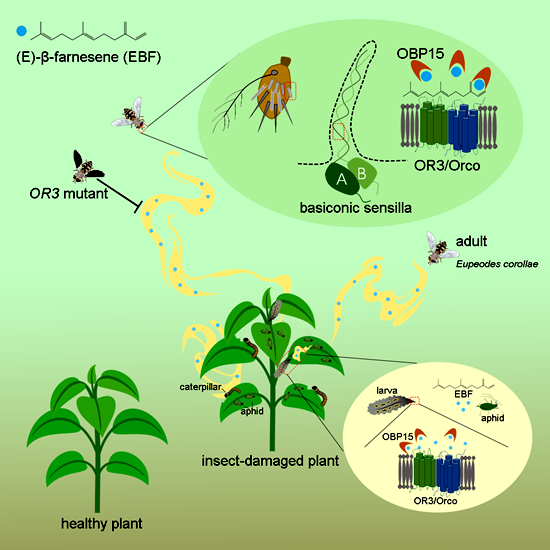IPPCAAS scientists revealed molecular basis of (E)-β-farnesene-mediated aphid location in the predator Eupeodes corollae
Recently, scientists from the Innovation Team for Research and Utilization of Functional Genes for Anti-insects at Institute of Plant Protection, Chinese Academy of Agricultural Sciences (IPPCAAS) has jointly revealed the molecular basis of (E)-β-farnesene-mediated aphid location in the predator Eupeodes corollae together with scientists from Austrian Institute of Technology GmbH, which was published as an article in the highly prestigious journal Current Biology.
Prof. Wang Guirong, Chief Scientist of the Innovation Team, pointed out that EBF has two origins, one of which was secreted by aphid as an alarm pheromone, and the other one was produced by the infested plant as a semiochemical to attract natural enemies. Earlier publication titled “Molecular basis of alarm pheromone detection in aphids” in Current Biology (2017) showed the detection of (E)-β-farnesene (EBF) in aphids is accomplished through a highly sensitive chemosensory system, involving the odorant receptor ApisOR5 and the odorant binding proteins ApisOBP3 and ApisOBP7, both chemosensory related proteins being essential for eliciting the repellent behavior of Acyrthosiphon pisum to EBF. Following a similar approach, the detection of and the attraction to EBF by hoverflies, natural enemies of aphids, were investigated.
To support these conclusions and to identify the biochemical tools used by the predator to find their meal, the authors have adopted several different approaches, including behavioral experiments, electrophysiological recording, expression of receptors in Xenopus oocytes and in the Drosophila “empty neuron”, and CRISPR/Cas9 gene knock-out, as well as production of recombinant odorant-binding proteins and ligand-binding assays. They unraveled the molecular mechanisms underlying detection of the EBF by hoverflies and attraction of these predators to their prey. They have also identified the odorant receptor (OR3) responsible both in larvae and adults for detecting EBF, and the odorant-binding protein (OBP15) acting as a specific carrier for this semiochemical. These results provide evidence that larvae are able to detect the small amount of EBF produced by aphids, while adults can be attracted to the much larger concentrations of the same chemical released by plants under aphid attack. Having identified the molecular mechanisms underlying attraction of hoverflies to aphids, they provide a contribution towards the complex strategies mediating interactions between insect pests, their host plants and predators, suggesting new approaches to interfere with their chemical language with the aim of controlling populations of both pests and beneficial insects.
More details can be found at the link below:
https://doi.org/10.1016/j.cub.2021.12.054
By Wang Bing (wangbing02@caas.cn)

-
 Apr 18, 2024Opening Ceremony of the Training Workshop on Wheat Head Scab Resistance Breeding and Pest Control in Africa Held in CAAS
Apr 18, 2024Opening Ceremony of the Training Workshop on Wheat Head Scab Resistance Breeding and Pest Control in Africa Held in CAAS -
 Apr 03, 2024IPPCAAS Co-organized the Training Workshop on Management and Application of Biopesticides in Nepal
Apr 03, 2024IPPCAAS Co-organized the Training Workshop on Management and Application of Biopesticides in Nepal -
 Mar 28, 2024Delegation from the School of Agriculture and Food Science of University College Dublin, Ireland Visit to IAS, CAAS
Mar 28, 2024Delegation from the School of Agriculture and Food Science of University College Dublin, Ireland Visit to IAS, CAAS -
 Mar 25, 2024Director of World Food Prize Foundation visited GSCAAS
Mar 25, 2024Director of World Food Prize Foundation visited GSCAAS -
 Mar 20, 2024Institute of Crop Sciences (ICS) and Syngenta Group Global Seeds Advance Collaborative Research in the Seed Industry
Mar 20, 2024Institute of Crop Sciences (ICS) and Syngenta Group Global Seeds Advance Collaborative Research in the Seed Industry
